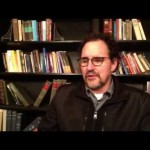We run our website the way we wished the whole internet worked: we provide high quality original content with no ads. We are funded solely by your direct support. Please consider supporting this project.

The Key to Understanding Revelation
The most important key to interpreting John’s violent imagery is found in the heavenly throne room scene in chapters 4-5. (For the first entry in this series on the violence in Revelation, click here.) This throne room represents heaven’s perspective on events that are occurring on earth, which is contrasted throughout Revelation with the false perspective of the “inhabitants of the earth” (8:13; 11:10; 13:8, 12, 14; 17:2). The only real battle that is waged throughout Revelation is a battle between truth and deception. It is, more specifically, a battle between the truth that the Lamb’s slaughtering was victorious and the lie that it was the Lamb’s defeat.
John invites us to see the truth by allowing us to witness the drama that is unfolding in the heavenly throne room. Here we find a mysterious sealed scroll, which contains the secret that Revelation unveils. The drama of this scene reaches a pinnacle when someone raises the question: “Who is worthy to break the seals and open the scroll?” (5:2). John weeps when no one is found worthy (5:4). How long before we learn the secret of the role that Jesus’ martyrdom plays in God’s victory over evil?
The answer is finally brought forth when John hears “one of the elders” in the throne room declare that “the Lion of the tribe of Judah, the Root of David, has triumphed,” and he is therefore worthy “to open the scroll and its seven seals” (5:3-5). This image represents the kind of enemy-slaying Messiah most first century Jews had been hoping for. But, surprisingly enough, when John looks to see this mighty messianic Lion, he instead beholds a little lamb that had already been slaughtered (5:6)!
Yes, John is saying, the Lion of the tribe of Judah has “triumphed,” but he triumphed not by violently slaying his enemies: he triumphed by becoming a slain little Lamb who offered up his life on behalf of his enemies. And yes, Jesus wages war with the aggression of a Lion, but the power that he aggressively wields is the Lamb-like power of self-sacrificial love that was perfectly manifested on the cross. In this way, John has transformed an image of power and domination into an image of vulnerability and nonviolence.
It is hard to overstate the importance of this remarkable symbolic transformation for our interpretation of Revelation. John’s transformation of the Lion of Judah into the sacrificial Lamb constitutes the climactic turn that anchors most of John’s other symbolic reversals. Once the Lion has been revealed to be the Lamb, we never again find Christ referred to as a Lion, though he’s referred to as the Lamb twenty-seven more times. Indeed, it is not an overstatement to say that the rest of the book of Revelation is simply an unfolding of the Lamb-like victory revealed in Revelation 5 and depicted (from a different angle) in Revelation 12. The remainder of Revelation, in other words, is an apocalyptic-like expression of the heavenly truth — spoken against all lies to the contrary — that by means of Jesus’ sacrificial death and the faithfulness of his followers, the “kingdom of the world has become the kingdom of our Lord and of his Messiah” (11:15).
Photo credit: Waiting For The Word via Visualhunt / CC BY
Category: General
Tags: Book of Revelation, End Times, Jesus, Violence
Topics: Biblical Interpretation
Related Reading

Jesus: True Myth and True History
Though the Jesus story gives us every reason to believe it is substantially rooted in history, it has a curious, and fascinating, relationship with myth and legend. The story of God coming to earth, being born of a virgin, manifesting a heroic, counter-cultural love toward outcasts, dying for the people who crucified him and then…

Revolting Against Classism
All fallen societies and religions have a tendency to rank people according to class. All have ways of separating the insiders from the outsiders, the holy from the unholy and the more important people from the less important people. Jesus revolted against classism by the way he lived, a way defined by the Kingdom. Now,…

Eye for Eye: That Time Jesus Refuted An Old Testament Teaching
One of the most surprising aspects of Jesus’ teaching is that, while he clearly shared his contemporaries’ view of the Old Testament as inspired by God, he was nevertheless not afraid of repudiating it when he felt led by his Father to do so (Jn. 8:28; 12:49-50; 14:31). For example, while the OT commands people…

Why Bart Ehrman Doesn’t Have to Ruin Your Christmas (Or Your Faith) Part 6
This is the sixth of several videos Greg put together to refute Bart Ehrman’s claims published in the article What Do We Really Know About Jesus? In this segment, Greg addresses the apparent discrepancies in the genealogies of Luke and Matthew and the implausibility of the idea that they were simply fabricated. We’ve been hearing that people are using…

Black Lives Matter, the Police, and Spiritual Warfare
Christ calls us to stand for a different kind of kingdom and this requires that we think in different ways about the violence that is gripping our country. In this short clip from Greg’s sermon this last weekend, we are introduced to a different way. Listen and hear the challenge to understand the deeper reality…

“Whatever it means, it cannot mean that.”
pure9 via Compfight Roger Olson wrote a great article a couple of days ago entitled Why (High) Calvinism Is Impossible. He points out that there is no way to understand God as “good” while also believing in double predestination. The idea that God predestines some to heaven and a vast majority to hell for his “glory”…
